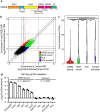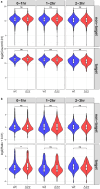This is a preprint.
The ORB2 RNA-binding protein represses translation of its target transcripts during the Drosophila maternal-to-zygotic transition via its functionally conserved Zinc-binding 'ZZ' domain
- PMID: 40672220
- PMCID: PMC12265677
- DOI: 10.1101/2025.07.10.664187
The ORB2 RNA-binding protein represses translation of its target transcripts during the Drosophila maternal-to-zygotic transition via its functionally conserved Zinc-binding 'ZZ' domain
Abstract
RNA-binding proteins (RBPs) are key components of the post-transcriptional regulatory machinery. We show that the ORB2 RBP, the Drosophila ortholog of human Cytoplasmic Polyadenylation Element Binding Protein (hCPEB) 2-4 protein family, binds to hundreds of maternally provided mRNAs in early embryos, identify a U-rich motif enriched in ORB2's targets, and show that this motif confers ORB2 binding and repression to a luciferase reporter mRNA in S2 tissue culture cells. ORB2's target transcripts are translationally repressed and unstable during the maternal-to-zygotic transition (MZT), a developmental phase during which a large proportion of maternally provided mRNAs are repressed and cleared. We show that, when tethered to a luciferase reporter, ORB2 and hCPEB2 (but not ORB and hCPEB1) repress translation and that the C-terminal Zinc-binding ('ZZ') domain of ORB2 is necessary and sufficient for repression. ORB2 interacts with a suite of post-transcriptional regulators in early embryos; a subset of these interactions is lost upon deletion of the ZZ domain, notably with the Cup repressive complex. Analysis of the early embryo's translatome in the presence or absence of the endogenous ZZ domain, shows that ORB2's targets move onto polysomes upon ZZ domain deletion, indicating that this domain mediates translational repression of ORB2's targets during the MZT. Together, our results assign a function to the ZZ domain and support a significant role for ORB2 in post-transcriptional regulation of maternal mRNAs during the Drosophila MZT.
Keywords: Cup; Cytoplasmic Polyadenylation Element Binding Protein (CPEB); ORB2; RNA-binding protein (RBP); S2 cell; embryo; maternal-to-zygotic transition (MZT); post-transcriptional regulation; pre-initiation complex (PIC); translational regulation.
Conflict of interest statement
Conflicts of Interest The authors declare that they have no conflicts of interest.
Figures






Similar articles
-
RNA binding protein HuR regulated by OIP5-AS1 may be involved in maternal transcript degradation during the human maternal-to-zygotic transition.BMC Genomics. 2025 Jul 1;26(1):600. doi: 10.1186/s12864-025-11807-3. BMC Genomics. 2025. PMID: 40597633 Free PMC article.
-
Tudor domain containing protein 5-like identifies a novel germline body and regulates maternal RNAs during oogenesis in Drosophila.Genetics. 2025 Apr 17;229(4):iyaf024. doi: 10.1093/genetics/iyaf024. Genetics. 2025. PMID: 39982762
-
The CPEB ortholog Orb2 regulates brain size through the TRIM-NHL RNA-binding protein, Brain tumor.bioRxiv [Preprint]. 2025 Jul 22:2025.07.18.665534. doi: 10.1101/2025.07.18.665534. bioRxiv. 2025. PMID: 40777385 Free PMC article. Preprint.
-
The maternal-to-zygotic transition.Curr Biol. 2024 Jun 3;34(11):R519-R523. doi: 10.1016/j.cub.2024.04.044. Curr Biol. 2024. PMID: 38834020 Review.
-
Methods for blood loss estimation after vaginal birth.Cochrane Database Syst Rev. 2018 Sep 13;9(9):CD010980. doi: 10.1002/14651858.CD010980.pub2. Cochrane Database Syst Rev. 2018. PMID: 30211952 Free PMC article.
References
Publication types
Grants and funding
LinkOut - more resources
Full Text Sources
